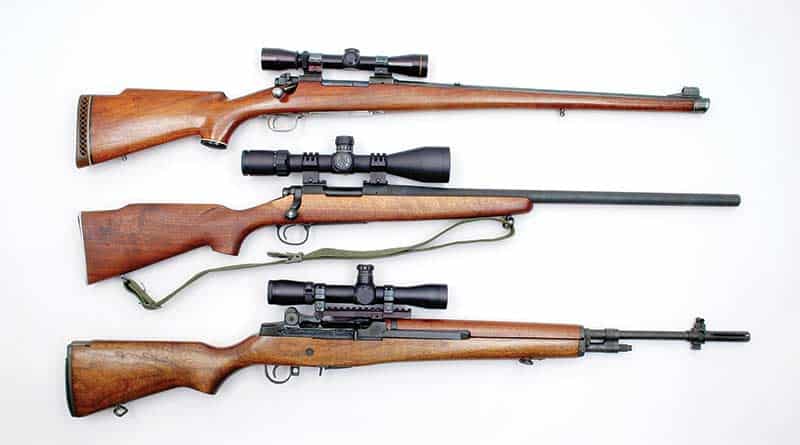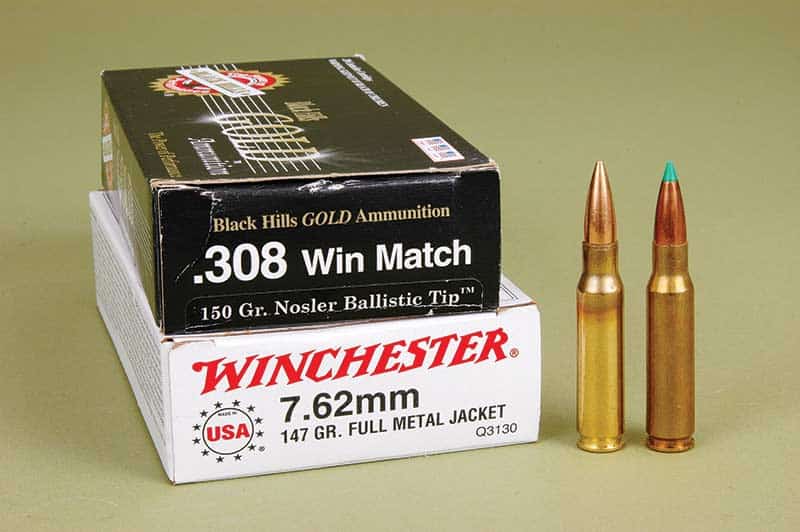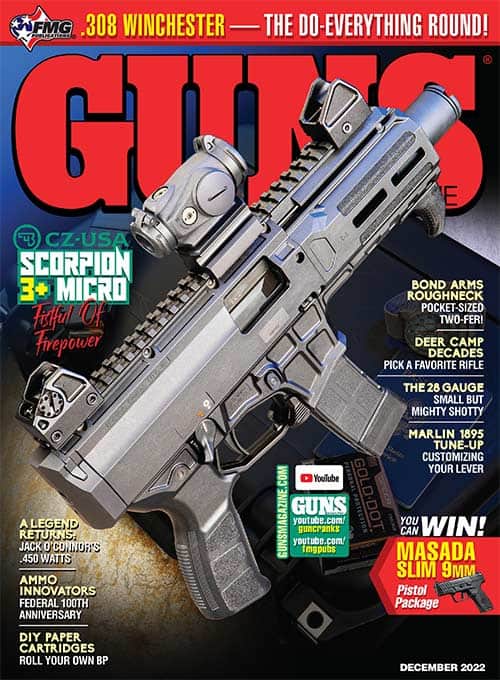The .308 Winchester
Best Cartridge Ever?
Quite often I’m asked, “What is your favorite gun?” With a smile I usually reply, “On what day?” Sometimes I’m more serious and ask back, “For what purpose: big game hunting, varmint shooting, self-protection, Cowboy competition, BPCR silhouette competition, plinking, antique-collecting?”
Simply The Best
One opinion of mine, however, is very strongly held. My all-time favorite hunting rifle has been a 1952 vintage Winchester Model 70 Featherweight chambered for a cartridge introduced that same year — the .308 Winchester. My use has been curtailed because health concerns forced me to give up big game hunting some years back. All of my modern caliber big game rifles were sold off with the single exception of my .308. It was kept “just in case.”
Also I should mention my 70-year-old Model 70 started out as a standard Featherweight but somewhere along the way a previous owner fitted it with a full-length Mannlicher-style stock of plain walnut with steel forend cap and rubber recoil pad. As far as rifles go, it’s not very attractive. Regardless, the moment I spotted it in a Bozeman, Mont., gun store’s used rifle rack, I knew it had to be mine.
That was 42 years ago and it has never let me down, which is different from saying I’ve never missed with it. I have, but not very often. Over the years I’ve shot coyotes, pronghorn antelope, mule deer and elk with the rifle. Only jacketed bullets were fired at game. All were 150-grain spitzers by Sierra and Nosler powered by 44 grains of IMR3031.
Many years ago Yvonne mentioned perhaps shooting big game herself. Therefore, I worked up a gentle load of 170-grain cast bullets (Lyman mold #311041) over 15 grains of Accurate 5744 so she could learn to shoot that rifle. With little trouble she became proficient with it but in the end, with an elk in her scope, she decided not to pull the trigger.
Casting Around
Speaking of cast bullets, when Remington introduced their re-creation of the U.S. Marine Corps M40 sniper rifle, I just had to have one. Not surprisingly, being chambered for .308 Winchester, it proved finely accurate. On a whim, I decided to give it a try with cast bullets. The bullet was from RCBS mold #308-200-SIL, a design I’d never tried previously. Loaded over 20 grains of Accurate 5744, the very first five-shot group fired was a mere 0.88″ at 100 yards. Rifles for this cartridge handle jacketed and cast bullets exceptionally.
The .308 Winchester was actually developed by American ordnance officers beginning with the .300 Savage cartridge case. What those fellows were searching for was .30-06 ballistics, i.e., 150-grain spitzers at approximately 2,700 fps. This was made possible with modern powders and slightly higher pressures in a case almost half-inch shorter than the old ’06s (2.494″ versus 2.015″). Even case head dimensions remained the same. Winchester got wind of the experimental round and in 1952 received permission to use it. This fact makes my Model 70 one of the earliest .308 Winchester sporting rifles.
NATO (North Atlantic Treaty Organization) was young then and participating countries wanted to adopt a standard cartridge. Several nations pushed their own ideas but the United States bulldozed them aside in favor of their new .30 caliber. It was adopted in 1954 as 7.62x51mm NATO. The U.S. Army didn’t begin receiving their new select-fire M14s until 1957 and then, in an unexpected move, stopped their manufacture in 1964 in favor of the new M16 5.56mm. The Belgian-made FN-FAL was likely the most-issued military rifle using 7.62x51mm NATO ammunition — they served around the world and still do.
Over the years I’ve owned many .308/7.62x51mm rifles. There were the two abovementioned bolt actions, plus a couple of Browning BLR lever guns, a Winchester Model 100 semi-auto, one FN-FAL, one AR10 and several Springfield Armory M1As. Perhaps the most interesting .308 I’ve owned was a 12+ lb. bolt action. I had it built for use in the local turkey shoots popular here in the Yellowstone Valley in the late 1970s. It had a Shilen barrel fitted to a commercial FN Mauser 98 action and was genuinely capable of half-inch, 100-yard groups. I sold it long ago, but just a few years past a fellow approached me at a gun show saying he ended up with it. However, his son felt the .308 was too puny and had it changed to a .300 Magnum. Bad move in my opinion.
As said in the beginning, I don’t hunt anymore but who knows. If times get really tough, lots of wild game roam through my Montana acreage.






